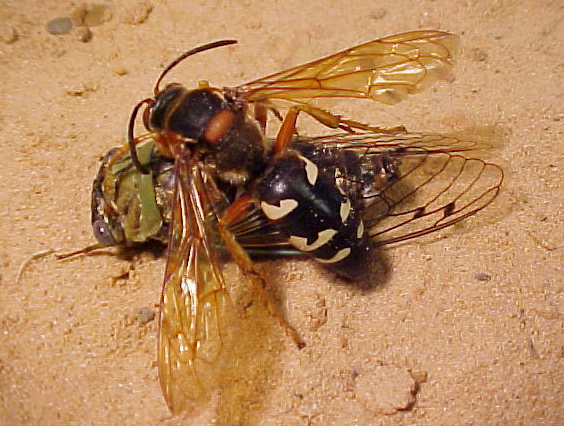Above: annual cicada; photo: Purdue University
In late July to early August each year, we are treated to the song of the annual cicadas. Or, maybe you call it the constant obnoxious ruckus of the annual cicadas. Annual cicadas are primarily nuisance pests, best known for the very loud, shrill, mating, and congregation calls that they make as adults.
Unlike their periodical cousins (the 17-year or 13-year cicadas), the annual cicada emerges every year as its name implies to loudly sing its constant, droning song. Campers and outdoor lovers will recognize the familiar song of the annual cicada in late summer. Their calls are as loud as 100 decibels. According to the U.S. Centers for Disease Control and Prevention (CDC), this noise level is roughly equivalent to an approaching subway train, a car horn at 16 feet, or crowd noise at sporting events, and hearing loss is possible after 15 minutes of continuous exposure.
Annual cicadas can be more than 2 inches long with very unique green or brown bodies and large black wide-set eyes. They have short antennae and clear wings held roof-like over the abdomen.

Annual cicada; photo: Purdue University
Some may call these insects locusts or katydids, but the correct term is cicadas. A true locust is a cousin of grasshoppers, which eat grasses and crops rather than sucking sap from tree roots. True katydids are also called long-horned grasshoppers for their long antennae, and they feed on the foliage of deciduous trees. Katydids make loud sounds, but rather than the constant shrill noise of the cicada, the sound is described as 2- to 4-part pulses, remembered by the mnemonic, ka-ty, ka-ty-DID, or ka-ty-DID-N’T.
Former Purdue Professor of Entomology, Tom Turpin, wrote that annual cicadas spend 2-4 years in the ground feeding on sap from tree roots, but due to staggering emergence schedules, some of them come out in late summer every year. So, their life cycle is not truly annual.
Annual cicadas are sometimes called “dog day” cicadas. “That name is based on the appearance of the cicadas about the time that Sirius - the dog star - is visible at sunrise during late July and early August,” wrote Turpin.
“The passed-down warning is that after the first call of the dog-day cicadas, there will be six weeks till frost,” said Turpin. “So, enjoy the weather while you can!” When annual cicadas are out, and if they are to be believed, cold weather is on the way.
Mark this passed-down warning up to a good legend, but not necessarily something accurate or predictive! “I have no idea about how accurate such predictions might be,” said Turpin.
Lastly, the emergence of annual cicadas also provides prey for cicada killers, a large native species of wasp that serves an important function in Indiana’s ecosystem. They’re up to 2 inches long and have black and yellow striped bodies with transparent yellow wings. I think they look like a fat, overgrown yellow jacket. They are sometimes confused with yellow jackets or hornets. Cicada killers are solitary insects that have burrows into the soil. They sting and drag cicadas into these burrows and lay their eggs in them to nourish their future young upon hatching.
Cicada killers rarely sting, but they may sting if a female is mishandled. Males may dive-bomb your head if you go near the nest, but they can’t sting.

A cicada killer and an annual cicada; photo: Purdue University